MINTON BUTCHER HIRT
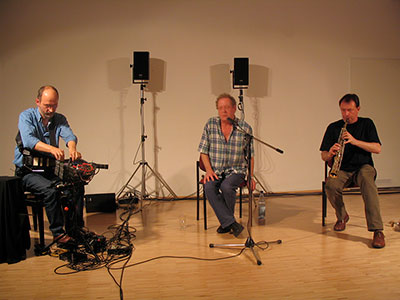
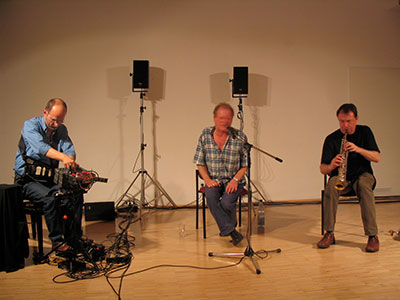

Exploratorium, Berlin 2006
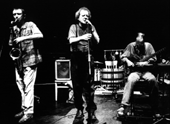
Phil Minton (UK), John Butcher (UK) and Erhard Hirt (Germany) first performed as a trio in 1991 - in London for the LMC. The group works within the vibrant tradition of new/improvised music - with each member a powerful individual stylist. Concerts and festivals have included Musique Action (Vandoeuvre-les-Nancy), Free Music (Antwerpen), November Music (Holland), Unerhört 11 (Bremerhaven), Prague, Arts Council tour of England. CD: TWO CONCERTS (FMP-OWN 90006)
Minton is probably the most impressive vocal performer working in Europe today
Penguin guide to jazz
Butcher breaks open the extremes of the saxophone to find a more considered tongue
Sunday Times
Hirt does not sound like other guitarists. That is the secret
Markus Müller
PHIL MINTON.......Voice
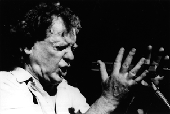
Phil Minton first played trumpet in the late 50s and by 1962 was playing and singing with the Mike Westbrook Orchestra. After living for five years in Sweden he returned to London in 1971 - touring with Westbrook, working with The Welfare State and IOU theatre companies - and in 75 formed the pioneering VOICE with Maggie Nichols and Julie Tippets. In the 80s he worked in Europe, Russia, America and Australia - in duo with Fred Frith, Roger Turner, Peter Brötzmann - in Lindsay Cooper's Oh Moscow, Trevor Watts' Moire Music - in Sally Potter's film Gold - and as a guest in many contexts. The 90s has included composing (with Veryan Weston) Songs from a prison diary - for 22 voices - (winner of the Cornelius Cardew 1991 Composition prize), Makhno - for 8 voices - (a Taktlos commission) and riverrun for his own quartet. He has sung with the London Symphony Orchestra, the Montreal Jubilation Choir (composed by Klaus Koenig), and his own Feral Choir Project (Stockholm and Berlin).
http://www.shef.ac.uk./misc/rec/ps/efi/mminton.html
JOHN BUTCHER....Saxophones
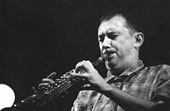
During the late 70s John Butcher worked mainly in jazz, whilst also completing a doctorate in theoretical physics. Since the early 80s he has worked almost exclusively in improvisation and 'new music'. Regular groupings include News from the Shed with Paul Lovens, a duo with singer Vanessa MackNess, and Frisque Concordance with Georg Graewe. His long standing musical association with pianist Chris Burn includes the 5-tet Embers as well as the 8-tet Ensemble. Much playing has occured in occasional/once-only groupings such as Derek Bailey's Company (90 & 92), John Steven's Spontaneous Music Ensemble, Radu Malfatti's Ohrkiste, the GrubenklangOrchester and with musicians such as Evan Parker, Steve Beresford, Gerry Hemingway. Solo concerts include Purcell Room, ICA (London), FMP "Total Music Meeting" (Berlin), Zurich and Copenhagen. Butcher has received three Arts Council Bursaries for saxophone research. He is a director of the LMC and runs ACTA records.
http://www.shef.ac.uk./misc/rec/ps/efi/mbutcher.html / http://www.johnbutcher.org.uk/
ERHARD HIRT.....Guitar and Electronics
http://www.efi.group.shef.ac.uk/mhirt.html
Reviews: MINTON-BUTCHER-HIRT CD: FMP OWN 90006 / 1997
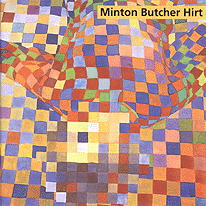
JAZZIZ / USA, May 98:
The Trio of U.K. vocalist Phil Minton, U.K. saxophonist John Butcher and German guitarist/electronics eclectician Erhard Hirt takes the improvconstruct to its outer limits. Its one-of-a kind Two Concerts (FMP) is definitely about sound. The music's development is not based on aninterlocking series of rhythms or tones or any other conventional structure. Rather, it's devised around mood and the progression of its texture and nuance. Yet the pair of suites on this album, recorded live at festival inVandoeuvre and Antwerp, end up making genuine compositional sense. That'sbecause Minton, Butcher and Hirt are seasoned soundtrack professionals whodon't need a Hollywood contract to conjure up tales via ultra-vivid noise. By turns freakish, nutty, scary, or cartoonish, Two Concerts is a heady experience that will leave most listeners incredulous. One could try to guess which sounds are coming from which instruments, but that's missing the
point (and sometimes, proves impossible). It's more appropriate to let the entire sound mass hurl toward you as a single entity. From the dense mix, one can discern many distinct elements: chainsaws, poltergeists, baby patter, gurgles, grinding machines, constipated groans, the manic gibberish of a sanatorium inmate, Donald Duck. But, unlike in the real world, these heterogeneous sound bites never compete with any another for dominance. This music is mythic, like an urban utopia: harmony where you'd least expect it.
Sam Prestianni
CADENCE (USA), Vol. 24, No. 6, June 1998:
To describe this trio music as a free improvisation between vocals, reeds, and guitar not only fails to do it justice, it completely misses the point. Minton, Butcher, and Hirt are more collaborative sound sculptors here, carving, shaping, twisting, and shredding the very acoustic space they are creating. Sorting out who is creating the buzzing drones; who the hushed, chirping trills; and who the sliding growls is often impossible, since the three shift roles and textures at a blurred pace. These three have all spent their careers exploring and extending the vocabulary of their respective instruments. They have shaped their improvising strategies by seemingly learning their instruments down to the most elemental units of sound source, and then reassembling from there. (It is impossible to talk of Minton's voice as anything less than an instrument.) This trio has been playing together for over six years, and their collective empathy shows. lf any one voice dominates here, it is Hirt. His fragmented electronic blasts and skittering sprays of machine-gun notes provide a ground for Minton and Butcher. Often, he seems to create a micro-symphony of oscillating, shimmering, and chiming electronics. This setting evokes a particular facet of Butcher's playing, focusing on the sounds of breath, keypads, and fluttering microtones which he tucks and wraps around Hirt's shards and Minton's acrobatic vocal gestures. Minton's stalling vocal technique can sometimes threaten to overwhelm in other settings. Here, he is perfectly keyed in to the other two players, drawing fully, on his phenomenal range and expansive timbral palette while eschewing the dramatic overtones he utilizes in his text-based music. These are spontaneous improvisations that develop an intuitive overarching structure. The result is electrifying as the three create music of textural depth and layered detail that continue to be revealed upon repeated listens. This is not music that is easy to absorb, but it is well worth the effort.Michael Rosenstein
Ihre Musik lediglich als freie Improvisation (von Stimme, Saxophon und Gitarre) zu beschreiben geht allerdings am eigentlichen Kern der Sache vorbei.Vielmehr sind Minton, Butcher und Hirt kolaborative Klang-Skulptoren, die durch „schnitzen, formen, verstricken und zerschnipseln“ einen akustischen Raum kreieren. Herauszubekommen wer summende Klangflächen, wer die leise zirpende triller und wer gleitende growls erzeugt ist oft unmöglich, da die drei in flißender Geschwindigkeit Rollen und Texturen tauschen. Alle drei haben ihre musikalischen Kariere in der Erforschung und Erweiterung des Vokabulars ihrer jeweiligen Instrumente gewidmet.Ihre Improvisationsstrategien gehen zurück zu den elementarsten Ursprüngen des Klanges um die musikalischen Elemente von dort aus völlig neu zusammen zu setzen.Hirts fragmentierte elektronische Explosionen und seine ungebärdigen Salven von Maschinengewehr-Noten bereiten den Grund für Minton und Butcher. Vielfach scheint er eine Mikrosymphonie oszillierender und flimmernder harmonischer Klänge zu erschaffen. Dies beschwört eine spezielle Facette in Butchers Spiel herauf, die, fokussiert auf den Klang des Atems und der Instrumentenklappen, erregt flatternder Mikrotöne um Hirt’s Klangscherben und Minton’s akrobatische Stimmgesten herumwickelt.Es ist unmöglich Mintons Stimme geringer als ein Instrument zu beschreiben. Droht seine
RESONANCE / GB:
As its title indicates, this CD is a recording of two concerts from 1995, the first from Music Action, Nancy, the second from the Free Music Festival, Antwerpen, a few months later. Interestingly, each piece, or concert, is divided and presented as 'parts', seven of the eight overall tracks clocking in at well under 10 minutes. Judging from the well timed and sudden fade outs, quite a bit of judicious editing of the material has taken place, abandoning the common documentary 'warts and all' approach, with a favourable and dramatic effect. Consequently what we have is a concise, cohesive, emotive and stimulating CD. John Butcher (saxophones) and Phil Minton (voice) are great together, each fuelling and challenging the other's immense and seemingly limitless resourcefulness. Erhard Hirt's contribution on guitar is often textural and spatial, always exploratory, giving what could otherwise be a stark music an extra dimension and ambience. Themes are constantly constructed and developed, with sudden and unexpected twists and turns keeping this listener engaged. This is a very mature and advanced (state of the heart?) improvised music; and a CD that necessitates close and repeated listening. Graham HalliwellRubberneck / GB:
Recent years have seen a resurgence in the use of the voice in improvised music.Minton is perhaps the most familiar of all improvising singers and for me by far the best. It is a joy then finally to get to hear his relatively longstanding trio with saxophonist Butcher and guitarist Hirt on disc. The array of sound and noise the trio convey is breathtaking. There is little use of 'traditional' techniques but instead sounds and textures are combined in an almost sculptural fashion. However, their music is by no means always abrasive and there are moments of the most delicate beauty, humour and warmth. This is improvising of the highest quality - quite simply superb.Bruce Coates
Neue Zeitschrift für Musik, BRD 4/98:
Gegeneinander / miteinander - zwei Positionen einer Produktion, deren Kennzeichen der absolute Wille zur Improvisation ist. Beide Begriffe schließen sich trotz der gegensätzlichen Aussagen nicht aus. Die Merkmale reichen am Ende der fünfundfünzig Minuten nicht aus, vorher geht es übereinander, hintereinander, untereinander, durcheinander. Es fällt auf, daß Phil Minton, der Vokalguru der freien Improvisationsszene, sich öfter verselbständigt als die Instrumentalisten. Sie suchen das Miteinander, ohne die gleiche Sprache zu sprechen. Und die Geburt einer Kakophonie (3rd part von Vandoeuvre) ist ohnehin eine sprachlose Angelegenheit; selbst Phil Minton muß husten, die Stimme säubern, die Kehle lockern. Der Ton der Gitarre ist als solcher unkenntlich, nur John Butcher gibt zu erkennen, daß das Saxophon noch ins landläufige Weltbild paßt. Teil zwei, Antwerpen benannt (vom Free Music Festival 1995), verzichtet gänzlich auf Identifikationspunkte.Die Geräuschkunst des Trios, das seit sechs Jahren aktiv gegen/miteinander spielt, hat längst das Pionierstadium eines Luigi Russolo verlassen, die Sounds nehmen eine zeitgenössische Form an.
Klaus Hübner
JAZZIZ, USA, May 98
The Trio of U.K. vocalist Phil Minton, U.K. saxophonist John Butcher and German guitarist/electronics eclectian Erhard Hirt takes the improv construct to its outer limits. Its one-of-a kind Two Concerts (FMP) is definitely about sound. The music's development is not based on an interlocking series of rhythms or tones or any other conventional structure. Rather, it's devised around mood and the progression of its texture and nuance. Yet the pair of suites on this album, recorded live at festival in Vandeuvre and Antwerp, end up making genuine compositional sense. That's because Minton, Butcher and Hirt are seasoned soundtrack professionals who don't need a Hollywood contract to conjure up tales via ultra-vivid noise.By turns freakish, nutty, scary, or cartoonish, Two Concerts is a heady experience that will leave most listeners incredulous. One could try to guess which sounds are coming from which instruments, but that's missing the point (and sometimes, proves impossible). It's more appropriate to let the entire sound mass hurl toward you as a single entity. From the dense mix, one can discern many distinct elements: chainsaws, poltergeists, baby patter, gurgles, grinding machines, constipated groans, the manic gibberish of a sanatorium inmate, Donald Duck. But, unlike in the real world, these heterogeneous sound bites never compete with any another for dominance. This music is mythic, like an urban utopia: harmony where you'd least expect it.
Jazzpodium, BRD: 10 / '98
Den drei ungleichen Partnern ist eines gemeinsam: Mit allen nur erdenklichen Mitteln produzieren sie Geräusche. Auch huldigen sie einer jazzmusikalischen Urtugend, der Improvisation. Phil Minton, John Butcher und Erhard Hirt, seit sechs Jahren gemeinsam auf Pfaden der Erkundung, suchen das Miteinander ohne die gleiche Sprache zu sprechen. So ist ihre CD voller Brüche, Widersprüche, aber auch überraschender kommunikativer Ansätze (die selten prozesshaft aufgebaut werden). Die instrumentellen Fähigkeiten und Findigkeiten sowie Ideen, sich einzubringen, werden stets neu formuliert. Und doch vermißt man den roten harmonischen Faden, der ein wirkliches Trio entstehen läßt. Was zählt, ist Gräuschkunst auf höherer Ebene.Reiner Kobe
the improvisor (The International web site on free improvisation)
Minton, Butcher, Hirt: Two Concerts CDJohn Butcher (saxophone), Erhard Hirt (guitar and electronics), Phil Minton (voice)
"Two Concerts" is the intersection of three strong stylistic axes in recent European free improvisation. John Butcher, and his Acta labelmates, have become renowned as precision craftsmen of extended techniques. They have the aesthetic and the intense focus of a Derek Bailey or John Stevens. Fellow Brit, Phil Minton, if he is appropriately associated at all, fits into the more "cinematic," or referential, traditions. Partly due to his instrument (voice) and partly due to his sense of humor, his music is evocative, extroverted, and often hilarious. Erhard Hirt is part of a necessarily more recent vintage of players who are mastering the seemingly infinite digital palette. Thus, as for Minton and Butcher, who are most often heard in the smoky acoustic settings inherited from jazz, Hirt's ways effectively drop them into a crackling, buzzing electronic landscape.
Ther is not something for everyone here, but that was never the point. Though Hirt plays guitar, your appeggiating pals will unlikely become converts to free improv based on this CD. Fans of Davey Williams, Bailey, and Henry Kaiser, however, might need to be prevented from salivating on it.
Hirt knows how to place his thwacks and shimmers. He can create a looming, Ligeti-like hammock of sound for the other players, and like a Bill Frisell, avoid becoming mere wallpaper.
Minton fans will find that several pieces bear his distinctive stamp. These are the most fun, if ever-so-slightly one-sided. What player, after all, can upstage a bel canto that manages to evoke musique concrete, Jabba the Hutt, auctioneers, and Yosemite Sam within a few breaths? Mintons technical range is subtly evinced on the more "serious" pieces in his ability to actually make the human voice sound just as alien as multiphonic saxophone and thoroughly modern guitar.
Butcher has a stunning ability to form "lines" by rummaging among diverse complexes of overtones and buzzing fundamental tones. There are very few saxophone noises here, as we humans have come to know them. Butcher is a bit more difficult to focus on, here, as compared to other acoustic recordings, and especially his solo works. He is often creating the most timbrally complex sounds in a group, and being able to hear all of the pieces of his puzzle makes his stuff seem more awe-inspiring. This CD is about the massive collective sound, however, and on that level it is entirely successful.
Speaking of the massive collective sound: small-group improvisers who use a lot of silence and "little sounds" in their work, could learn much from "Two Concerts" about documenting their work. Engineer Peter Cusack and producers Butcher and Hirt point to a new way, beyond the pervasive "hit-REC-and-let-it-run" approach to recording. An combination of miking, compression, and mixing, among other techniques are crucial aspects of what makes this CD a unique work. With most recordings of acoustic music, the listener gets a clear sense of location and separation, so that one can identify precisely the series of sounds that an individual contributes to the whole. "Two Concerts" rarely sounds like three guys in a room or on a stage. This is good, since recordings are incapable of substituting for live performances, anyway.
Wyman Brantley
Contact:
Erhard Hirt; cuba-cultur, Achtermannstrasse 12, D-48143 Münster, Tel +49(0)251/22343, Fax +49(0)251/22397 e-mail:hirt@muenster.deJohn Butcher; ACTA-Rec., 28 Aylmer Road, London W12 9LQ, Tel/Fax +44(0)181 / 740 1349 JBACTA@msn.com
Home